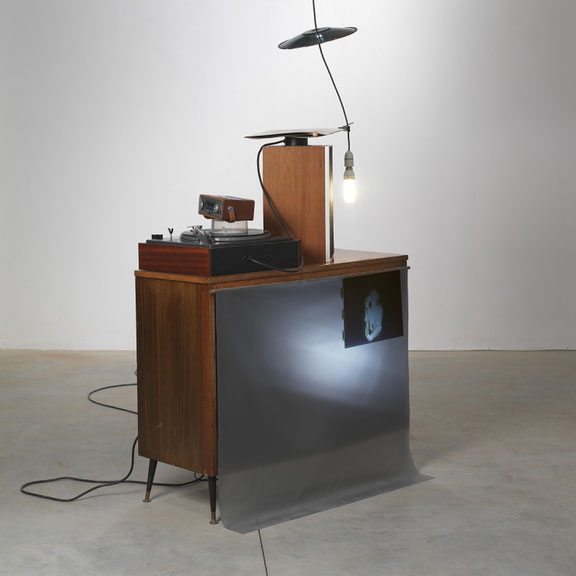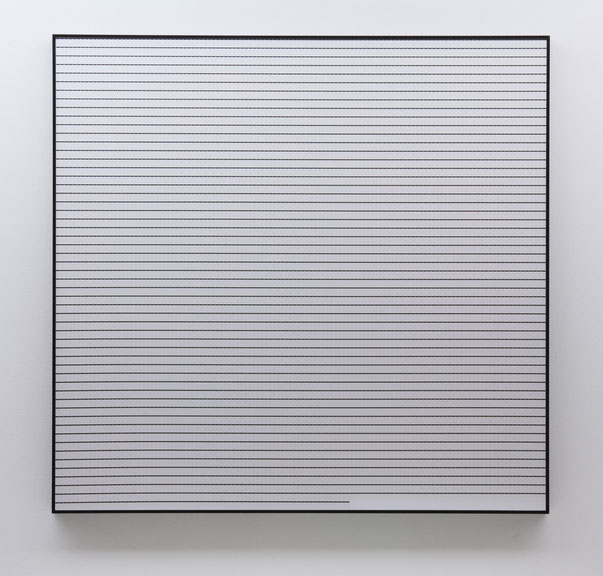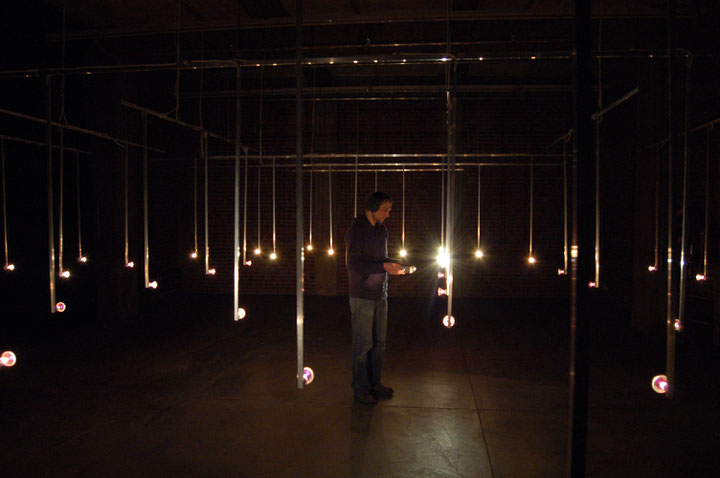Issue 3/2012 - Net section
Sound Art Exhibitions 1975–2013
A eulogy on the occasion of the »Sound Art« exhibition at ZKM Karlsruhe
»Out of print« should by all rights no longer be an unquestionable category. To speak of »books lost due to unavailability« (Max Goldt) does not stand up to closer inspection, at least since the creation of AAAAARG.ORG. In May 2011, the title in question was still listed as a »rare classic« in the bibliography »TONSPUR_library ∞ Sound+Art in books,«1 initiated by Georg Weckwerth and described as a »collection and title archive of available publications and backlist of out-of-print titles on the thematic complex sound+art,« even though a digital copy of the book »Sound Sculpture,« published by John Grayson, had long been in circulation via Ubuweb.2 This »first publication to deal completely with this new art form« appeared in 1975 as a catalogue accompanying the eponymous, genre-encompassing exhibition at the Vancouver Art Gallery (which included works by Stephan von Huene, Harry Bertoia, and Bernard and François Baschet). In the exhibition catalogue, the contributing artists attempted to foresee the direction sound sculpture would take in the future – a topic introduced by Grayson with the assumption: »We enter a period of a more global and direct concept of art. Art, in its highest form may soon cease to exist as a conventional material medium. This includes Sound Sculpture.« It is symptomatic that, among all the speculations by the exclusively male participants in the exhibition, nobody thought about the most obvious future change in the genre – because what really should have been said is that: »Art, in its highest form may soon cease to exist as a conventional male medium. This includes Sound Sculpture.«
The exhibition that can currently be viewed and heard at the ZKM Center for Art and Media in Karlsruhe, »Sound Art. Sound as a Medium of Art«3 (including works by Stephan von Huene, Harry Bertoia, and Bernard and François Baschet) does not (at least tendentially) share this slanted view of »Sound Sculpture.« It is troubled however by a different problem, which is in fact closely related to Grayson’s actual assumption, but in a different way than what he would have meant; the problem is namely not only of a conceptual but also a techno-sociological nature. If »Sound Sculpture« is regarded as the first comprehensive exhibition of this genre,4 then »Sound Art« can be understood as the very last exhibition to focus entirely on sound art. There is no other way to explain the exhibition’s lack of orientation, putting the object that produces the sound at center stage and explicitly relying on haptic and visual support in order to convey the sensuality of sound. In this sense, despite an iPad-guided tour through the diverse developments in acoustic art, which is said to go »far beyond installations and sculptures,« the curators fail to offer any conclusions as to the future consequences of the (complete) digitization of auditory production. Instead, this state of affairs is simply taken for granted. »Sound Art« virtually imposes itself as the keystone of a development that began with »Sound Sculpture.«
Nevertheless, the exhibition certainly achieves the goals it set itself: it seeks to present – through the works of over 100 international artists, a third of which are new productions – no more and no less than the »history of sound art in the twentieth century« as well as »the current state of sound art in the twenty-first century.« Curated by the ZKM chairman Peter Weibel and co-curated and produced by Julia Gerlach, the project coordinator at the ZKM Institute for Music and Acoustics, the exhibition tends toward the encyclopedic and canonical. There is talk of the ZKM transforming itself into a »palace of sound« for this exhibition, which aims to make the visitors »themselves into creators of sound,« in line with the art historical premise: »anything that creates a sound became an instrument.« Apparently, »sound experiences come to life« here, and visitors can investigate their own sense of hearing. Thus, it can be said that the ZKM seeks to strike a populist blow for an art genre that has reached a historical crisis point in terms of its specialist status, in an era when millions of people produce and edit their own artistic sounds on home computers or the internet. To this end, the exhibition gathers together over two atriums at the Center for Art and Media and across the Karlsruhe cityscape a whole series of genuinely important and groundbreaking historical as well as contemporary works in the genre of sound art. The classic, in some cases interactive, sound sculptures showcased in Grayson’s exhibition, such as those in Harry Bertoia’s »Sonambient« series, the filigree sound objects with speakers and photocells created by Peter Vogel in the 1980s, or the electric guitar cast in concrete by Douglas Henderson (2007), a picture of which was used to advertise the exhibition, occupy little space here. Room-filling installations and environments making use of multiple media, such as Edwin van der Heide’s »Sound Modulated Light 3« (2007), which consists of a portable machine inside a room full of light bulbs whose flickering produces audio signals, are also more the exception. Typical instead are works that use different kinds of media to explore how sounds are perceived in certain, sometimes deceptive, ways, and how visual cues can support or undermine this impression. Examples include Gordon Monohan’s speaker box from the series »Music from Nowhere« (1989/90), in which the sounds that can be heard are not recordings or broadcasts amplified by the loudspeaker but are instead generated by small technical devices inside the speaker itself; or Timo Kahlen’s »Tanz für Insekten« (Dance for Insects, 2010), in which dead insects lying atop vibrating loudspeakers seem to hover due to the oscillations of the membranes, while the clatter of their shells creates further irritation. Furthermore, there are video works such as Christan Marclay’s »Guitar Drag« (2000), showing an electric guitar being dragged through some bushes by a car, resulting in a feedback performance made up of a combination of random effects and nature; or Cory Arcangel’s »Drei Klavierstücke op. 11« (Three Piano Pieces Opus 11, 2009), in which the artist reconstructs Arnold Schönberg’s »Three Piano Pieces« from online videos of cats playing the piano.
Both the extensive accompanying program with its own iPhone and iPad app,5 as well as the embedding of documentary material, sometimes including whole archives, are characteristic for the exhibition. Documentations of works by the musicians and audio artists Daphne Oram and Maryanne Amacher are for example given their own space. Carl Michael von Hausswolff and Friedrich Jürgenson’s audio tape archive of radio phone communications with the dead is assembled here, as is an archive collection from the experimental concert and performance venue »Het Apollohuis« in Eindhoven (1980–1997). Taking all this into consideration, it certainly speaks for the concept and set-up of the show that the curators have been able to avoid one of the main issues that sound exhibitions face – the different works do not impinge here on each other’s perception.
What is extremely puzzling nonetheless is that the Karlsruhe exhibition tends to present the genre of sound art in a quasi-retrospective, very matter-of-fact way, without any further conceptual emphasis or delimitation, belying the existence of ambitious previous exhibitions such as »Sonambiente« (Berlin 1996 and 2006), »Crossings« (Vienna 1998), »Sonic Boom« (London 2000), »Frequenzen [Hz]« (Frankfurt 2002), »Sonic Process« (Paris 2002), or others focusing on more specific and therefore more interesting concepts such as gender and sound (for example »Her Sound,« London 2005). All of these would seem to be lost due to unavailability – out of print, so to speak. Missing here is a curatorial approach that delves into the media archeology of sound art rather than merely tracing its history, and one that ventures to engage with the theme of unavailability instead of simply putting archives on display.
Sound Art. Sound as a Medium of Art, ZKM Karlsruhe, 17 March 2012 to 6 January 2013.
Translated by Jenny Taylor
1 http://library.tonspur.at
2 www.ubu.com/historical/sound_sculpture/index.html
3 http://soundart.zkm.de
4 The 1970 exhibition »Sound Sculpture As« curated by Tom Marioni at the Museum of Conceptual Art in San Francisco can also be seen as incomplete for the same reasons.
5 http://itunes.apple.com/de/app/sonor-field/id508438585?mt=8


